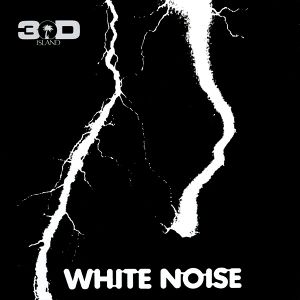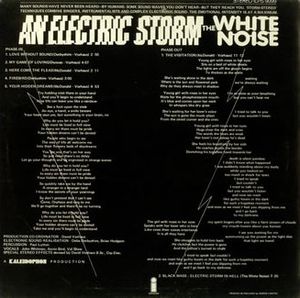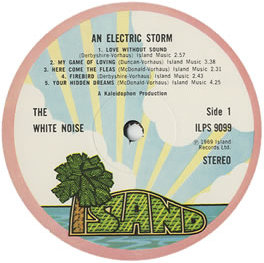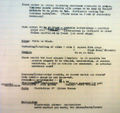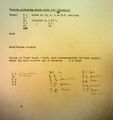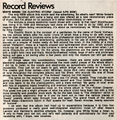Difference between revisions of "An Electric Storm"
Martinwguy (talk | contribs) |
Martinwguy (talk | contribs) |
||
| (10 intermediate revisions by the same user not shown) | |||
| Line 1: | Line 1: | ||
| − | {{Thumb|An Electric Storm master tape labels}} | + | {{Thumb|DD165602|[[DD165602]]: An Electric Storm master tape labels}} |
{{Thumb|An Electric Storm 1969 album cover}} | {{Thumb|An Electric Storm 1969 album cover}} | ||
{{Thumb|An Electric Storm 1969 album back cover}} | {{Thumb|An Electric Storm 1969 album back cover}} | ||
| Line 27: | Line 27: | ||
<BLOCKQUOTE> | <BLOCKQUOTE> | ||
[[Brian Hodgson]]: “[White Noise] was very advanced for its time but it never quite gelled for me. It was just not part of the stream of things that was going on at the time, it went off at a tangent, and it became a cult album. Pity it didn’t become one at the time! It was as if Island released it on the secret list.”<ref>[[Brian Hodgson]] interviewed for [[Breege Brennan's thesis]].</ref> | [[Brian Hodgson]]: “[White Noise] was very advanced for its time but it never quite gelled for me. It was just not part of the stream of things that was going on at the time, it went off at a tangent, and it became a cult album. Pity it didn’t become one at the time! It was as if Island released it on the secret list.”<ref>[[Brian Hodgson]] interviewed for [[Breege Brennan's thesis]].</ref> | ||
| + | </BLOCKQUOTE> | ||
| + | |||
| + | <BLOCKQUOTE> | ||
| + | “she told me 'firebird' and 'love without sound' pre-dated the rest of that stuff by a couple of years and that vorhaus was the one who did most the rest of it.”<ref name=pk>[[Pete Kember]], personal communication.</ref> | ||
</BLOCKQUOTE> | </BLOCKQUOTE> | ||
| Line 32: | Line 36: | ||
=Timeline= | =Timeline= | ||
| − | |||
| − | |||
| − | |||
* 15th February 1969: David Vorhaus writes to Miss Astrahan about the album cover art.<ref name=DD164714/> | * 15th February 1969: David Vorhaus writes to Miss Astrahan about the album cover art.<ref name=DD164714/> | ||
* 16th February 1969: Delia and David Vorhaus were “working each night flat out on our record”.<ref name=DD165533/> | * 16th February 1969: Delia and David Vorhaus were “working each night flat out on our record”.<ref name=DD165533/> | ||
* September/October 1969:<ref name=DD141127/> The album is reviewed<ref name=DD141319/> in "Clanfolk", the BBC folk song club magazine.<ref name=DD141044/> | * September/October 1969:<ref name=DD141127/> The album is reviewed<ref name=DD141319/> in "Clanfolk", the BBC folk song club magazine.<ref name=DD141044/> | ||
* 27th September 1969:<ref name=DD154843/> An advert<ref name=DD154941/> and a scathing review<ref name=DD154918/> appear in "Time Out in London" magazine. | * 27th September 1969:<ref name=DD154843/> An advert<ref name=DD154941/> and a scathing review<ref name=DD154918/> appear in "Time Out in London" magazine. | ||
| − | |||
| − | |||
=Track list= | =Track list= | ||
| Line 50: | Line 49: | ||
* '''S4''': [[Here come the Fleas]] | * '''S4''': [[Here come the Fleas]] | ||
* '''S5''': [[Your Hidden Dreams]] | * '''S5''': [[Your Hidden Dreams]] | ||
| + | which is presumably the order in which the tracks were created. | ||
==Side 1: "PHASE IN"== | ==Side 1: "PHASE IN"== | ||
| Line 55: | Line 55: | ||
===[[Love Without Sound]]=== | ===[[Love Without Sound]]=== | ||
(Derbyshire/Vorhaus)<BR> | (Derbyshire/Vorhaus)<BR> | ||
| − | + | A romantic piece about making love without sound was the first song recorded by White Noise and the one that got them the Island deal. All strings are double-bass parts played by [[David Vorhaus]] sped up to sound like violins, cellos and violas.<ref name=jayedelman>jayedelman's [http://www.oocities.org/jayedelman/whitenoise.html ''An Electronic Storm - The White Noise''] on geocities.com</ref> | |
{{Spectrogallery|Love Without Sound}} | {{Spectrogallery|Love Without Sound}} | ||
Latest revision as of 16:48, 16 June 2021
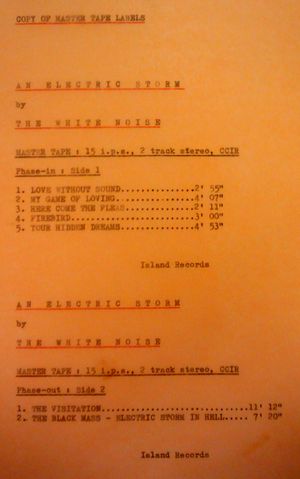
At Kaleidophon with David Vorhaus, Brian Hodgson and others, Delia helped create the seminal album An Electric Storm.
Contents
Quotes
Many sounds have never been heard - by humans. Some soundwaves you don't hear - but they reach you. 'Storm-Stereo' techniques combine singers, instrumentalists and complex electronic sound. Welcome to the world of the Frequency Shifter, Signal Generator and Azimuth Co-ordinator. A world that existed before the dawn of the synthesizer, when a 'sample' was a length of recording-tape delicately and skillfully spliced in place.[1]
I think my forte is, well, apart from having an analytical mind to do electronic sound, at the opposite end I'm very good at writing extended melody for which there was not really an opening at the BBC. And so I met this guy, I was giving a lecture at Morley College in London and he came up to me afterwards. He played the double bass, the same as I did, and he was already doing tracks for the Ballet Rambert and we got together and started this album.[2]
“It's common knowledge now that the first couple of tracks were actually recorded in the BBC. They were unaware of us using the studio and equipment for our own ends.”[3]
“[The] album that reconciled pop music with the experimental avant-garde... resembled as much a scientific experiment as any conventional musical document... The result is a set of eerie, delightful songs that, for all their surface simplicity, shimmer with vestigial synthesiser swells, strange echoes, disembodied voices, and distant music-box trills.”[4]
Brian Hodgson: “[White Noise] was very advanced for its time but it never quite gelled for me. It was just not part of the stream of things that was going on at the time, it went off at a tangent, and it became a cult album. Pity it didn’t become one at the time! It was as if Island released it on the secret list.”[5]
“she told me 'firebird' and 'love without sound' pre-dated the rest of that stuff by a couple of years and that vorhaus was the one who did most the rest of it.”[6]
There is an excellent review of the whole album White Noise: Electric Storms, Radiophonics and the Delian Mode] on John Coulthart's Feuilleton.
Timeline
- 15th February 1969: David Vorhaus writes to Miss Astrahan about the album cover art.[7]
- 16th February 1969: Delia and David Vorhaus were “working each night flat out on our record”.[8]
- September/October 1969:[9] The album is reviewed[10] in "Clanfolk", the BBC folk song club magazine.[11]
- 27th September 1969:[12] An advert[13] and a scathing review[14] appear in "Time Out in London" magazine.
Track list
The Kaleidophon internal names for the tracks were:[15]
- S1: Love Without Sound
- S2: Firebird
- S3: My Game of Loving
- S4: Here come the Fleas
- S5: Your Hidden Dreams
which is presumably the order in which the tracks were created.
Side 1: "PHASE IN"
Love Without Sound
(Derbyshire/Vorhaus)
A romantic piece about making love without sound was the first song recorded by White Noise and the one that got them the Island deal. All strings are double-bass parts played by David Vorhaus sped up to sound like violins, cellos and violas.[16]

My Game of Loving
(Duncan/Vorhaus)
Lyrics were written by Georgina Duncan, Annie Bird sings throughout, the track has an uncanny resemblence to American counterparts Donald Byrd and the Field Hippies and the United States of America. Vorhaus had to construct one 'electronic' orgy and after having lived with it for a bit, combined it with the recording of a real orgy. What a drag that must have been.[16]

Here come the Fleas
(McDonald/Vorhaus)
An obvious single choice, though never a single. Kenny Everett used the first percussive break, after verse one, as a jingle on his radio programme. Brian Hodgson plays the Carribean gentleman asking for the music to be turned down as he can't hear his own steel band. Very Island Records. Co-Written with John Renn-Mc-Donald.[16]

Firebird
(Derbyshire/Vorhaus)
The second song recorded by White Noise,[16] actually an old song of Delia's[17] orchestrated to a cornucopia of tape-twiddling sound effects.

Your Hidden Dreams
(McDonald/Vorhaus)
A trippy ode to LSD.

Side 2: "PHASE-OUT"
The Visitation
(McDonald/Vorhaus)
Light out, headphones on -- a trip on a motorcycle to see a girlfriend ends in a fatal accident. In true 'Truly Madly Deeply' fashion he visits his beau but only for 'such a hopeless moment'. This took 3 months to record, was co-written by John Renn-McDonald and became idolised as the heaviest trip on the album. A triumph of sound and splicing tape.[16]

The Black Mass: Electric Storm in Hell
(White Noise)
Island Records are on the 'phone demanding a finished album and you've seven minutes of tape left and only one day to fill it, what would you do? Answer: the group-jam in a live performance. This was admittedly inspired by Pink Floyd's 'Saucerful of Secrets' with ex-dentist Paul Lytton on drum. Georgina Duncan wrote the lyrics at the beginning of the track.

Papers
- Folder DD335 contains Delia's papers for An Electric Storm
DD165602: Copy of master tape labels
DD164817: Typewritten draft credits
DD164833: Typewritten cover design
DD165644: Specification for fluorescent album cover ink
DD165651: Handwritten notes for album cover
DD165442: Typewritten draft of text for album cover
DD165435: Typewritten draft of text for album cover "2nd version"
DD165501: Typewritten draft of credits for album cover
DD165703: Typewritten text for album cover side one - early version
DD165812: Typewritten text for album cover side one
DD165749: Typewritten text for album cover side two
DD165618: Notes: "Factors affecting track order for 'phase-in'"
DD164714: Letter dated 15th February 1969 from David Vorhaus to Miss Astrahan, the cover designer.
DD165533: Letter dated 16th February 1969 from Delia to Brian about plumbing.
DD141044: Cover of the BBC Clanfolk magazine
DD141127: Page 2 of Clanfolk
DD141319: Review of An Electric Storm in Clanfolk
DD154843, Cover of Time Out in London
DD154941: Advert for the album in Time Out in London
DD154918: Scathing review in Time Out in London
There are further papers (lyrics, manuscripts) for each of the pieces, listed on the tracks' individual pages.
Availability
- Released on vinyl 1968, Island Records, Cat: 510 948-2.
- Released on vinyl in June 1969, Island Records, Cat: ILPS 9099.[18]
- Released on CD, 28 July 1992 by Island Records.
- Released on CD, 28 Dec 1999 by Polygram Int'l.
- Rereleased in digitally remastered version on CD in Jul 2007 available on boomkat.com with catalogue number 9843197
References
<references> [11] [9] [10] [12] [14] [13] [7] [8] [15]
- ↑ The sleeve notes for An Electric Storm.
- ↑ Delia in the Radio Scotland interview.
- ↑ Attributed to the sleeve notes for An Electric Storm in Breege Brennan's thesis, but probably from her interview with Brian Hodgson.
- ↑ Credited to ”Louis Pattison, BBC, on re-release of Electric Storm 2007” in Breege Brennan's thesis
- ↑ Brian Hodgson interviewed for Breege Brennan's thesis.
- ↑ Pete Kember, personal communication.
- ↑ 7.0 7.1 DD164714: Letter dated 15th February 1969 from David Vorhaus to Miss Astrahan, the cover designer.
- ↑ 8.0 8.1 DD165533: Letter dated 16th February 1969 from Delia to Brian about plumbing.
- ↑ 9.0 9.1 DD141127: Page 2 of the BBC Clanfolk magazine containing a review of the albim.
- ↑ 10.0 10.1 DD141319: Review of the album in Clanfolk magazine.
- ↑ 11.0 11.1 DD141044: Cover of the BBC Clanfolk magazine containing a review of the album.
- ↑ 12.0 12.1 DD154843, Cover of Time Out in London, dated Sept.27 - Oct.11.
- ↑ 13.0 13.1 DD154941: Advert for the album in Time Out in London magazine.
- ↑ 14.0 14.1 DD154918: Review of the album in Time Out in London magazine.
- ↑ 15.0 15.1 DD165618: Handwritten notes for "Factors affecting track order for 'phase-in'".
- ↑ 16.0 16.1 16.2 16.3 16.4 jayedelman's An Electronic Storm - The White Noise on geocities.com
- ↑ I forget where I heard that - maybe from James Percival or in his thesis.
- ↑ White Noise - An Electric Storm on discogs.com
